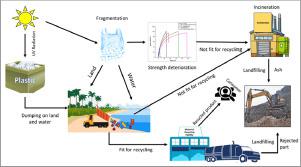Resources, Conservation and Recycling ( IF 11.2 ) Pub Date : 2021-02-20 , DOI: 10.1016/j.resconrec.2021.105494 Ved Prakash Ranjan , Sudha Goel

|
Global demand for plastics, especially in the packaging sector, is increasing exponentially due to the worldwide shift from reusable plastics to single-use plastics. Packaging plastics consist mainly of polyethylene (PE), and polypropylene (PP)). Therefore, PP and PE contribute a significant portion of plastic waste polluting terrestrial and aquatic environments. In this study, the effect of UV radiation on polypropylene exposed to four different environmental conditions (air, double distilled water (DDW), potable water and saline water) was observed for 30 days. Physical, chemical, and mechanical changes were evaluated to assess the potential for mechanical recycling. Results show that all physical, mechanical, and chemical properties were severely affected for samples exposed to the air environment, followed by DDW and potable water medium, causing the material to be less elastic and more brittle. Samples exposed to saline water were found to be resistant to mechanical changes. Cracks, holes, and flakes were seen in SEM images of samples exposed to air and DDW medium, but no changes were seen on the surfaces of samples exposed to potable and saline water. Variation in surface roughness of samples with changes in their media was observed in AFM 2D topographical images. Changes observed in samples exposed to different media suggest that PP recovered from the terrestrial environment gets fragmented within 1 month making it difficult to collect and therefore, it is no longer fit for recycling. However, PP recovered from the marine environment does not deteriorate within 1 month and can be sent for recycling.
中文翻译:

暴露于四种不同环境条件后聚丙烯的可回收性
由于全球范围内从可重复使用的塑料向一次性塑料的转变,全球对塑料的需求,尤其是在包装领域,对塑料的需求呈指数级增长。包装塑料主要由聚乙烯(PE)和聚丙烯(PP)组成。因此,PP和PE构成了塑料废物的很大一部分,污染了陆地和水生环境。在这项研究中,观察到紫外线辐射对暴露于四种不同环境条件(空气,双蒸馏水(DDW),饮用水和盐水)的聚丙烯的影响达30天。评估了物理,化学和机械变化,以评估机械回收的潜力。结果表明,暴露于空气环境的样品对所有物理,机械和化学性质均会产生严重影响,其次是DDW和饮用水介质,导致材料的弹性降低,变脆。发现暴露于盐水的样品具有抗机械变化的能力。暴露于空气和DDW介质的样品的SEM图像中可见裂纹,孔洞和薄片,但暴露于饮用水和盐水的样品表面未见变化。在AFM 2D地形图图像中观察到样品表面粗糙度随介质变化的变化。在暴露于不同介质的样品中观察到的变化表明,从陆地环境中回收的PP在1个月内破碎,难以收集,因此不再适合回收利用。但是,从海洋环境中回收的PP在1个月内不会变质,可以将其回收再利用。发现暴露于盐水的样品具有抗机械变化的能力。暴露于空气和DDW介质的样品的SEM图像中可见裂纹,孔洞和薄片,但暴露于饮用水和盐水的样品表面未见变化。在AFM 2D地形图图像中观察到了样品表面粗糙度随介质变化的变化。在暴露于不同介质的样品中观察到的变化表明,从陆地环境中回收的PP在1个月内破碎,难以收集,因此不再适合回收利用。但是,从海洋环境中回收的PP在1个月内不会变质,可以将其回收再利用。发现暴露于盐水的样品具有抗机械变化的能力。暴露于空气和DDW介质的样品的SEM图像中可见裂纹,孔洞和薄片,但暴露于饮用水和盐水的样品表面未见变化。在AFM 2D地形图图像中观察到了样品表面粗糙度随介质变化的变化。在暴露于不同介质的样品中观察到的变化表明,从陆地环境中回收的PP在1个月内破碎,难以收集,因此不再适合回收利用。但是,从海洋环境中回收的PP在1个月内不会变质,可以将其回收再利用。在暴露于空气和DDW介质的样品的SEM图像中可以看到薄片和薄片,但是暴露于饮用水和盐水的样品的表面没有看到变化。在AFM 2D地形图图像中观察到了样品表面粗糙度随介质变化的变化。在暴露于不同介质的样品中观察到的变化表明,从陆地环境中回收的PP在1个月内破碎,难以收集,因此不再适合回收利用。但是,从海洋环境中回收的PP在1个月内不会变质,可以将其回收利用。在暴露于空气和DDW介质的样品的SEM图像中可以看到薄片和薄片,但是暴露于饮用水和盐水的样品的表面没有看到变化。在AFM 2D地形图图像中观察到了样品表面粗糙度随介质变化的变化。在暴露于不同介质的样品中观察到的变化表明,从陆地环境中回收的PP在1个月内破碎,难以收集,因此不再适合回收利用。但是,从海洋环境中回收的PP在1个月内不会变质,可以将其回收再利用。在暴露于不同介质的样品中观察到的变化表明,从陆地环境中回收的PP在1个月内破碎,难以收集,因此不再适合回收利用。但是,从海洋环境中回收的PP在1个月内不会变质,可以将其回收再利用。在暴露于不同介质的样品中观察到的变化表明,从陆地环境中回收的PP在1个月内破碎,难以收集,因此不再适合回收利用。但是,从海洋环境中回收的PP在1个月内不会变质,可以将其回收再利用。











































 京公网安备 11010802027423号
京公网安备 11010802027423号